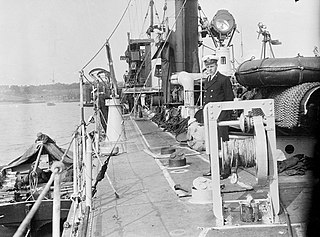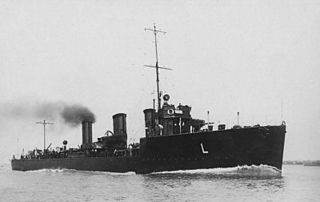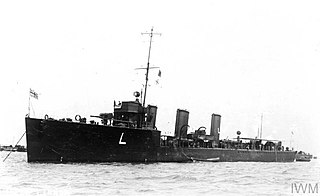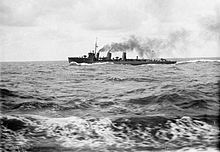HMS Ossory was an Admiralty M-class destroyer built for the Royal Navy during the First World War. She took part in the Battle of Jutland in 1916 and was sold for scrap in 1921.

HMS Lance was a Laforey-class destroyer of the Royal Navy. Launched a few months before the outbreak of the First World War and attached to the Harwich Force, Lance took part in several engagements during the war, including the sinking of the Königin Luise and the Battle off Texel. She was responsible for firing the first British shot of the war.

HMS Laforey was the lead ship of her class of destroyer built for the Royal Navy. Launched a year before the First World War began, she was attached to the Dover Patrol. Laforey saw action in several engagements with German torpedo boats, including the Battle off Noordhinder Bank and the action of 17 March 1917. Laforey was sunk in 1917 by a British mine after escorting several freighters to France. She was named for Francis Laforey, captain of HMS Spartiate at the Battle of Trafalgar in 1805.

HMS Laertes was a Laforey-class destroyer built for the Royal Navy during the 1910s.

HMS Legion was a Laforey-class destroyer built for the Royal Navy during the 1910s.

HMS Lennox was a Laforey-class destroyer built for the Royal Navy during the 1910s.
HMS Laverock was a Laforey-class destroyer of the Royal Navy. She was launched in 1913 and entered service in October 1914. Laverock served through the First World War, operating with the Harwich Force and in the English Channel. She was sold for scrap in 1921.

HMS Partridge was a Royal Navy Admiralty M-class destroyer constructed and then operational in the First World War, later being sunk by enemy action in 1917. The destroyer was the sixth Royal Navy vessel to carry the name HMS Partridge.
HMS Pheasant was one of 85 Admiralty M-class destroyers built during the First World War for the Royal Navy. She hit and was sunk by a mine in 1917.
HMS Negro was an Admiralty M-class destroyer of the Royal Navy. She was built by Palmers and launched 8 March 1916, but was sunk after colliding with HMS Hoste in the North Sea on 21 December 1916; depth charges from Hoste exploded and blew out Negro's hull plating. The ship was the second Royal Navy warship to bear the name Negro with the first being the 1813 Negro, ex-Niger.

HMS Landrail was a Laforey-class destroyer of the British Royal Navy. The Laforey class was the class of destroyers ordered under the Royal Navy's 1912–1913 construction programme, which were armed with three 4-inch (102 mm) guns and four torpedo tubes and were capable of 29 knots. The ship, which was originally to be named Hotspur but was renamed before launch, was built by the Scottish shipbuilder Yarrow between 1912 and 1914,
HMS Lark was a Laforey-class destroyer of the British Royal Navy. The Laforey class was the class of destroyers ordered under the Royal Navy's 1912–1913 construction programme, which were armed with three 4-inch (102 mm) guns and four torpedo tubes and were capable of 29 knots. The ship, which was originally to be named Haughty but was renamed before launch, was built by the Scottish shipbuilder Yarrow between 1912 and 1913.

HMS Redgauntlet was an R-class destroyer which served with the Royal Navy. Launched on 2 July 1916, the ship operated as part of the Harwich Force during World War I and then, after the War, with the Home Fleet. While taking part in an anti-submarine patrol on 21 May 1917, the ship struck a mine but, although severely damaged, was able to return to England for repairs. Subsequently, the destroyer joined the anti-submarine school at Portsmouth before being sold to be broken up on 16 December 1926 after less than ten years service.

HMS Laurel was a Laforey-class destroyer which served with the Royal Navy. Launched on 6 May 1913 as HMS Redgauntlet, the ship was renamed on 30 September under an Admiralty order to become one of the first alphabetical class destroyers. On commissioning, the vessel joined the 3rd Destroyer Flotilla and operated as part of the Harwich Force during the First World War. During Battle of Heligoland Bight, Laurel led a flotilla that pursued German torpedo boats, engaging with G194 and G196, and was damaged in action with the cruiser Mainz. The vessel also played a minor role in the Battles of Dogger Bank, Dover Strait and Jutland. With the cessation of hostilities, the ship was placed in reserve and scrapped on 1 November 1921.

HMS Liberty was a Laforey-class destroyer that served with the Royal Navy during the First World War. Launched on 15 September 1913 as HMS Rosalind, the ship was renamed on 30 September under an Admiralty order to become one of the first alphabetical class destroyers. On commissioning, the vessel joined the Third Destroyer Flotilla and operated as part of the Harwich Force. During Battle of Heligoland Bight, Liberty engaged with the German torpedo boats G194 and G196, and scored two hits on the cruiser Mainz. On 8 February 1917, the destroyer rammed and sank the German submarine UC-46. The vessel also played a minor role in the battles of Dogger Bank, Dover Strait and Jutland, as well as acting as a convoy escort and patrolling the Dover Barrage. With the cessation of hostilities, the ship was placed in reserve and sold to be broken up on 5 November 1921.

HMS Linnet was a Laforey-class destroyer that served with the Royal Navy during the First World War. Launched on 16 August 1913 as HMS Havock, the ship was renamed on 30 September under an Admiralty order to become one of the first destroyers in a class named alphabetically. This convention subsequently became the norm. On commissioning, the vessel joined the Third Destroyer Flotilla and operated as part of the Harwich Force. The destroyer was first commanded by Commander Loftus Jones who named his daughter Linnette after the ship. During the War, the destroyer took part in the Battle of Heligoland Bight in 1914, and escorted minelayers on missions to lay mines. It was during one the latter missions that the ship was nearly hit by a gun hurled from the stricken minelayer Amphion. With the cessation of hostilities, the ship was placed in reserve and sold to be broken up on 4 November 1921.

HMS Lysander was a Laforey-class destroyer that served with the Royal Navy during the First World War. Launched in August 1913 as HMS Ulysses, the ship was renamed the following month under an Admiralty order to become one of the first in what would be the norm, a class of destroyers named after successive letters of the alphabet. On commissioning, the vessel joined the Third Destroyer Flotilla and operated as part of the Harwich Force. The destroyer took part in the Battle of Heligoland Bight in 1914, attacking the German light cruiser Mainz and escorted the seaplane carriers Engadine and Riviera in an abortive attempt to attack the Cuxhaven airship base. During 1915, Lysander undertook anti-submarine patrols and escorting duties, coming under fire from German short-based batteries while accompanying the mine-laying paddle-steamers Prince of Wales and Queen Victoria off the coast of Ostend. In 1916, the destroyer was involved in action with German battlecruisers following the bombardment of Yarmouth and Lowestoft but escaped unharmed, and rescued the survivors from the Canadian hospital ship Llandovery Castle in 1918. With the cessation of hostilities, the ship was placed in reserve and sold to be broken up in June 1922.

HMS Redoubt was an R-class destroyer which served with the Royal Navy during World War I. The R class was an improvement of the preceding M-class, primarily through having geared steam turbines which offered greater efficiency and range. Launched on 28 October 1916, the ship joined the Harwich Force, operating as part of a destroyer flotilla undertaking convoy escort and anti-submarine operations in the North Sea. During 1918, Redoubt took part in an experiment to launch fighter aircraft from a lighter towed beyond a destroyer. The first flight took place on 1 August and the first successful operation ten days later when the Sopwith Camel flew by Lieutenant S.D. Culley took off and destroyed the German airship LZ 100. After the war, the vessel was transferred to the Home Fleet but was sold on 13 July 1926 to be broken up, part of a large scale disposal of older destroyers by the Navy.

HMS Llewellyn was a Laforey-class destroyer that served with the Royal Navy. Laid down on 14 December 1912 as HMS Picton, the ship was renamed on 30 September 1913 under an Admiralty order to become one of the first alphabetical class destroyers, being launched on 30 October. On commissioning, the vessel joined the Third Destroyer Flotilla and operated as part of the Harwich Force during the First World War. The destroyer took part in the Battle of Heligoland Bight, as well as undertaking anti-submarine patrols and escort duties. It was during one of these patrols on 4 December 1916 that the vessel unsuccessfully attacked the German submarine UB-18. On 17 March 1917, the destroyer was struck in the bow by a torpedo launched by a German torpedo boat while rescuing survivors from the sunk destroyer Paragon, but returned to port safely by steaming backwards. With the cessation of hostilities, the ship was placed in reserve. Although subsequently offered for sale to the Finnish Navy, Llewellyn was instead withdrawn from service and sold to be broken up on 18 March 1922.

HMS Lawford was a Laforey-class destroyer of the British Royal Navy. The Laforey class was the class of destroyers ordered under the Royal Navy's 1912–1913 construction programme, which were armed with three 4-inch (102 mm) guns and four torpedo tubes and were capable of 29 knots. The ship, which was originally to be named Ivanhoe but was renamed before launch, was built by the Scottish shipbuilder Fairfields between 1912 and 1914.














